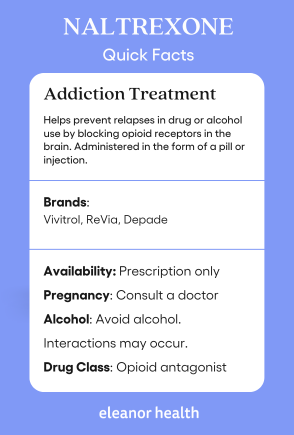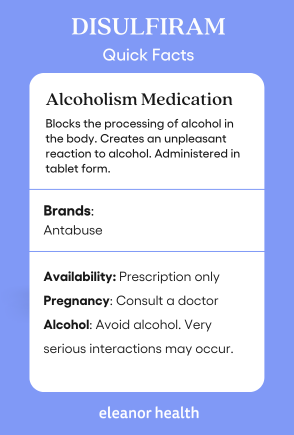Medications like disulfiram (also known as Antabuse) and naltrexone can be strong tools to help you manage Alcohol Use Disorder (AUD) when prescribed as part of Medication-Assisted Treatment. These medications differ in their mechanisms of action, effects on alcohol consumption, and general side effects. Understanding these key differences before you start treatment can help you choose the option that’s best for you.
Naltrexone is widely regarded as the first-line medication of choice to treat alcohol use disorder. Approved by the Food and Drug Administration (FDA) for this specific purpose, naltrexone has garnered significant recognition for its efficacy in curbing alcohol cravings and reducing the pleasurable effects of drinking.

Disulfiram is considered a second-line option for individuals who do not respond well to naltrexone. While naltrexone reduces cravings and the enjoyment associated with drinking, disulfiram primarily acts as a deterrent to drinking due to the severe reactions that occur if alcohol is ingested while on the medication.

Naltrexone is classified as an “opioid antagonist”, meaning it blocks certain receptors in the brain called mu-opioid receptors. These receptors are involved in the pleasure and reward system of the brain. When someone drinks alcohol or uses opioids, these substances activate the mu-opioid receptors, leading to feelings of euphoria or a “high”. Naltrexone binds to these receptors and prevents them from being activated.
If a person consumes alcohol or opioids while on naltrexone, they won’t feel the usual pleasurable effects, and cravings will decrease.
When you drink alcohol, your body breaks it down into a chemical called acetaldehyde. Disulfiram blocks the enzyme that normally breaks down this chemical. If you drink alcohol while on disulfiram, this chemical will build up on your body and cause unpleasant symptoms like flushing, nausea, vomiting, headaches, dizziness, and chest pain. This is known as the “disulfiram-alcohol reaction”. The effects of disulfiram can last for up to 2 weeks after your last dose.
Naltrexone is available in two formulations, catering to individual preferences and treatment needs. Disulfiram is available in oral tablet form. Both medications are prescription-only.
Disulfiram tablets typically come in 250 mg doses. They are usually administered once daily. It’s highly recommended that disulfiram be taken under supervision, whether by a healthcare professional or a trusted family member. This practice enhances accountability and ensures adherence, as the disulfiram-alcohol reaction can be severe and potentially life-threatening if alcohol is consumed while taking the medication.
The oral tablet form can be taken daily or on an as-needed basis, a practice known as “targeted naltrexone,” which allows individuals to strategically take the medication before high-risk situations or events where heavy drinking may occur. Naltrexone tablets typically come in 50 mg doses.
Naltrexone is also available as a 380 mg long-acting injectable (Vivitrol). This form is administered by a healthcare professional every four weeks, offering a convenient alternative for those who may struggle with daily adherence.
As with any pharmacological intervention, both disulfiram and naltrexone carry the potential for side effects. While most side effects are mild, serious side effects can occur, particularly if a patient has certain co-occurring conditions. Before starting either treatment, inform your doctor about your medical history and any medication you might be taking.
Common side effects associated with disulfiram include:
More serious concerns involve the risk of liver damage, which can manifest as jaundice, abdominal pain, nausea, and dark urine. Individuals with severe heart conditions or psychotic disorders may be advised to avoid disulfiram altogether.
While generally well-tolerated, naltrexone can cause side effects such as:
Injection site reactions may occur with the long-acting formulation (Vivitrol). Naltrexone should be avoided in individuals currently taking opioid medications or experiencing opioid withdrawal symptoms, as it can precipitate severe withdrawal reactions. Liver function monitoring may be necessary, particularly at higher doses of naltrexone.
While disulfiram and naltrexone can be powerful tools in the fight against alcohol addiction, they represent just one aspect of addiction treatment.
Cognitive-behavioral therapy, support groups, and lifestyle modifications are crucial components of a holistic approach to recovery, complementing medication-assisted treatment with psychological and emotional support to achieve your goals, whether it’s sobriety or cutting down your drinking.
This whole-person approach is the cornerstone of our outpatient addiction program at Eleanor Health. We offer both online and in-person support to patients looking for supportive and affordable treatment in Louisiana, Massachusetts, New Jersey, North Carolina, Ohio, Texas
and Washington.
 Virtual Addiction Treatment: is it as Effective as In-Person Treatment?
Virtual Addiction Treatment: is it as Effective as In-Person Treatment?
 How to Stop Alcohol Drinking Safely: The Journey Towards Recovery
How to Stop Alcohol Drinking Safely: The Journey Towards Recovery
 Does Insurance Cover Online Rehab and Medication-Assisted Treatment?
Does Insurance Cover Online Rehab and Medication-Assisted Treatment?